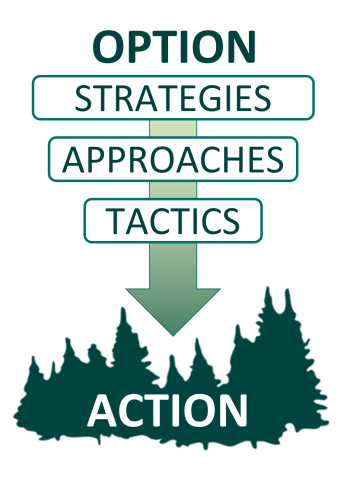Natural resources practitioners working in Great Lakes coastal ecosystems face decisions about how to help coastal properties adapt to climate changes.
Strategies for Adapting Great Lakes Coastal Ecosystems to Climate Change presents a menu of adaptation actions to help practitioners move from general concepts to tangible, targeted adaptation tactics for their system. This menu draws on a wide range of literature and contemporary reports, in addition to the expertise of regional managers and scientists convened by the U.S. Fish and Wildlife Service and the Northern Institute of Applied Climate Science.
Effects from Climate Change
The Great Lakes contain nearly 20% of the earth’s total surface fresh water and over 9,400 miles of coastline. Climate change has and will continue to impact the physical, chemical, and biological processes of the Great Lakes, and coastal ecosystems face a unique set of challenges due to these impacts. Across the broader Great Lakes region ecosystems are experiencing: changing thermal regimes, changing storm and precipitation patterns, and shifts in species assemblages. In addition, coastal ecosystems face stressors that are specific to their proximity to the Great Lakes, including shrinking lake-ice cover, extent, and duration; increasing periods of wave action that accelerate erosion; and changing water levels that could exceed historical highs and lows as well as the pace of change.

Adaptation in Action
This menu of coastal adaptation strategies and approaches, like other adaptation menus that have been developed, presents a diverse set of options for responding to climate change in Great Lakes coastal ecosystems. It draws from and complements previously published adaptation menus, including those for forested watersheds, non-forested wetlands, culturally relevant tribal perspectives, forests, and others. However, given the unique climate challenges faced by coastal ecosystems throughout the Great Lakes, this menu focuses more specifically on: coastal wetlands and estuaries; dunes and open beaches; rivers, deltas and riparian areas; stream channels; forested coasts and swamps; rock cliffs and bluffs; embayments; and nearshore habitats.
The Strategies for Adapting Great Lakes Coastal Ecosystems menu is designed to be used as a stand-alone resource, and it can also be used to supplement structured adaptation planning with the Adaptation Workbook process (published in Forest Adaptation Resources: Climate Change Tools and Approaches for Land Managers).

Strategies and approaches
The 6 strategies, 32 approaches, and 100+ tactics were developed through an assessment of existing adaptation tools, focus group discussions, and workshops with natural resource professionals.
Adaptation strategies are very general and can be applied in many ways across different ecosystems and cultural contexts. Adaptation approaches are more specific, describing in greater detail how strategies could be put into practice.
These strategies and approaches are designed to serve as stepping stones to allow natural resource managers and planners to translate broad concepts into targeted and specific actions (tactics) for putting climate change adaptation into practice to achieve a specific management objective in a specific location.
Example tactics are provided in the menu as illustrations of a few of the possible actions that could implemented for climate adaptation.
Menu of Strategies and Approaches for Great Lakes Coastal Ecosystems
-
Approach 1.1: Maintain and restore natural sediment transport processes.
Approach 1.2: Maintain and restore hydrological connectivity between hydrological features.
Approach 1.3: Maintain and enhance infiltration and water storage capacity of soils.
-
Approach 2.1: Moderate water temperature increases.
Approach 2.2: Reduce sediment deposition.
Approach 2.3: Reduce loading and export of nutrients and other pollutants.
-
Approach 3.1: Maintain the integrity of unique plant communities, coastal wetlands and estuaries, and their integral landforms. .
Approach 3.2: Minimize non-climate physical damage to coastal ecosystems and habitats. .
Approach 3.3: Establish living shorelines by maintaining and restoring coastal vegetation. .
Approach 3.4: Maintain and enhance species and structural diversity in coastal ecosystems. .
Approach 3.5: Prevent invasive plant and animal species establishment and minimize their impacts where they occur. .
Approach 3.6: Maintain and establish refugia for plants and animals. .
Approach 3.7: Maintain and increase connectivity of coastal habitats.
-
Approach 4.1: Manage coastal ecosystems to accommodate increased frequency and duration of low water levels.
Approach 4.2: Manage coastal ecosystems to accommodate increased frequency and duration of high water levels.
Approach 4.3: Promote features that reduce the impacts of wind and wave energy or damage from coastal erosion.
Approach 4.4: Manage sediment to respond to fluctuating water levels.
Approach 4.5: Reduce or manage surface water runoff.
Approach 4.6: Maintain and create conditions for inland and waterward movement of plants and animals.
Approach 4.7: Manage impounded wetlands to accommodate changes in hydrologic variability.
-
Approach 5.1: Favor or restore native species and genotypes with wide moisture and temperature tolerances.
Approach 5.2: Increase genetic diversity of seed and plant mixes.
Approach 5.3: Disfavor species that are distinctly maladapted.
Approach 5.4: Introduce species that are expected to be adapted to future conditions.
Approach 5.5: Move at-risk species to locations that are expected to provide more suitable habitat.
-
Approach 6.1: Reinforce infrastructure to meet expected conditions.
Approach 6.2: Design infrastructure with low-impact or ecologically friendly features.
Approach 6.3: Adjust the placement, design, and planned lifespan of infrastructure.
Approach 6.4: Remove infrastructure and readjust systems.
Citation
Schmitt, K.; Krska, R.; Deloria, C.; Shannon, P.D.; Cooper, M.; Eash, J.; Haugland, J.; Johnson, S.E.; Johnson, S.M.; Magee, M.R..; Mayne, G.; Nelson, C.; Nigg, C.; Sidie-Slettedahl, A.; Brandt, L., Handler, S.; Janowiak, M.; Butler-Leopold, P.; Ontl, T.; and Swanston, C. 2022. Strategies for Adapting Great Lakes Coastal Ecosystems to Climate Change. White Paper. Houghton, MI: U.S. Department of Agriculture, Northern Forests Climate Hub. 61 p, https://doi.org/10.32747/2022.7816961.ch.
Acknowledgments
This is a joint product of the USDA Northern Forests Climate Hub, the U.S. Fish and Wildlife Service, and the Northern Institute of Applied Climate Science, a collaborative, multi-institutional partnership led by the USDA Forest Service.



